8. LUMINAIRES
8.1 PROPER USE
Regiolux luminaires may only be equipped with light sources specified on the identification plate and in the approval certificates. Use of other lamps as well as LED and T5 adapters does not constitute proper use according to intentions
and may lead to functional impairment and danger. As a part of our legal product monitoring obligation in accordance with Paragraph 6 Section 4 of the German Product Safety Act (ProdSG) we explicitly refer to these dangers. In the event of damage, legal problems can be expected.
8.2 SPECIAL OPERATING CONDITIONS
Luminaires are subject to a number of external influences. Under certain circumstances, this can mean harsher operating conditions for luminaires which have an effect e.g. on the service life of the luminaires and lamps. Such effects may result in warranty limitations and even loss. The manufacturer should be asked directly about the effects of such special operating conditions on the luminaires. The following represents a short overview with selected examples.
8.2.1 Mains power supply
Regiolux luminaires are designed for a sinusoidal alternating voltage of 230 V and 50 Hz (see fig. 8.6.). In other cases (e.g. foreign countries), ballasts must be adapted to the actual values of the supply voltage. For this reason the existing network construction and its values/tolerances must be regarded. This also applies to network deficiencies. In particular, overvoltage may lead to damage of the components in extreme cases. Sources of interference must be eliminated, if necessary together with the power supply company.
8.2.2 Electromagnetic compatibility
Electromagnetic compatibility (EMC) is defined by both interference immunity
of the luminaires against external disturbance factors and emitted interference to external systems. Various standards define corresponding limitation values. Despite conformity to these limitation values, in particular cases disturbances may occasionally occur (e.g. radio transmission). In such cases, interference immunity of the electrical devices should be inspected. Possible actions for
avoidance of disturbances are increasing the distance between the luminaire
and electrical device or modification of the wave band for signal transmission.
8.2.3 Ambient temperature
Regiolux luminaires are designed for an ambient temperature of 25° C (see fig. 8.6.). If in practice the ambient temperature strongly differs (e.g for cold stores or workshops with process heat), we should be contacted for specifying to what extent the selected luminaires can be approved for the corresponding temperature conditions. In particular, operation under higher ambient temperatures may lead to malfunctioning of e.g. the electronic ballast (see fig. 7.1.2.). In this case special luminaires may be required.
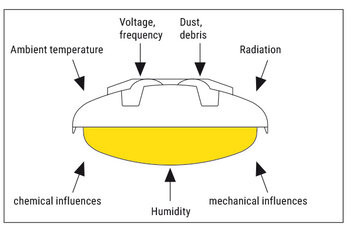
8.2.4 Chemical influences
Environments with particular chemical substances in the atmosphere can have a range of effects on lamps, luminaires and lighting systems.
8.2.4.1 Resistances of plastics
The resistance table gives an overview of the chemical stability of the most important plastics used for luminaire construction. Specifications for chemical resistance are related to an ambient temperature of approx. 22° C.
For cleaning of the diffuser/housing it is recommended to use a weak solution of the suitable agent. Limited use of chemical cleaning agents is allowed.
8.2.4.2 Resistances of electronic components and LED
Under certain circumstances, chemicals may also have an influence on electronic components, circuit boards and LED. For example, luminaires with electronic components and PCBs can be damaged due to increased concentrations of ammonia in the atmosphere.
LED can also be sensitive to chemical influences. For example, atmospheres with an increased proportion of sulphur compounds or chlorides are considered critical and can result in occlusions, discolorations and reduction of the service life.
| Clearing agents | PMMA | PC |
|---|---|---|
|
Scouring agent |
beständig | beständig |
| All-purpose glue | resistant | partially resistant |
| All-purpose cleaning agent | resistant | resistant |
| Mild detergent | resistant | resistant |
| Hair setting lotion | resistant | resistant |
| Nail polish/-remover | not resistant | not resistant |
| Perchloroethylene | not resistant | not resistant |
| Detergent | resistant | partially resistant |
| Cleaning agent for acrylic glass | resistant | resistant |
| Pril washing-up liquid | resistant | resistant |
| Cleaning agent for glass | not resistant | resistant |
| Silicone oil | resistant | resistant |
| Washing-up liquid | partially resistant | resistant |
| Special-purpose cleaning agent Tri | not resistant | not resistant |
| Chemical substance | Polyester | Acrylic glass | Polycarbonate |
|---|---|---|---|
| Acetone | not resistant | not resistant | not resistant |
|
Aliphat. |
partially resistant | partially resistant | resistant |
| Alcohol up to 30 % | resistant | resistant | resistant |
| Alcohol concentrated | partially resistant | not resistant | not resistant |
| Ammonia 25 % | not resistant | beständig | not resistant |
|
Accumulator acid |
resistant | resistant | resistant |
| Aniline | not resistant | not resistant | not resistant |
| Aromat. hydrocarbons |
partially resistant | not resistant | not resistant |
| Ether | partially resistant | not resistant | not resistant |
| Ethyl acetate | not resistant | not resistant | not resistant |
| Benzine | resistant | resistant | resistant |
| Benzole | not resistant | not resistant | not resistant |
| Beer | resistant | resistant | resistant |
| Blood | resistant | resistant | resistant |
| Bromine acid | not resistant | not resistant | not resistant |
| Chloroform | not resistant | not resistant | not resistant |
| Chlorophenol | not resistant | not resistant | not resistant |
| Diesel oil, crude oil | resistant | resistant | partially resistant |
| Dioxane | resistant | not resistant | not resistant |
| Acetic acid up to 5 % | resistant | partially resistant | resistant |
| Acetic acid up to 30 % | resistant | not resistant | partially resistant |
| Glycerine | resistant | resistant | partially resistant |
| Glycol | resistant | resistant | resistant |
| Glysantine | resistant | resistant | resistant |
| Carbon dioxide | resistant | resistant | resistant |
| Carbon monoxide | resistant | resistant | resistant |
| Lime water | resistant | resistant | partially resistant |
| Saline | resistant | resistant | resistant |
| Ketone | not resistant | not resistant | not resistant |
| Lysol | not resistant | not resistant | not resistant |
| Sea water | resistant | resistant | resistant |
| Methylene chloride | not resistant | not resistant | not resistant |
| Methyl alcohol | not resistant | not resistant | not resistant |
| Metal salts and their watery solutions | resistant | resistant | resistant |
| Sodium hydroxide 2 % | partially resistant | resistant | not resistant |
| Sodium hydroxide 10 % | not resistant | resistant | not resistant |
| Petroleum ether | resistant | resistant | partially resistant |
| Pyridine | not resistant | not resistant | not resistant |
| Phenol | not resistant | not resistant | not resistant |
| Nitric acid up to 10 % | resistant | resistant | resistant |
| Nitric acid 10 to 20 % | partially resistant | partially resistant | partially resistant |
| Nitric acid over 20 % | not resistant | not resistant | not resistant |
| Hydrochloric acid up to 20 % | resistant | resistant | resistant |
| Hydrochloric acid over 20 % | resistant | resistant | partially resistant |
| Sulphuric acid up to 50 % | resistant | resistant | resistant |
| Sulphuric acid up to 70 % | resistant | partially resistant | partially resistant |
| Sulphuric acid over 70 % | not resistant | not resistant | not resistant |
| Sulphurous acid up to 5 % | partially resistant | partially resistant | not resistant |
| Hydrogen sulphide | resistant | resistant | resistant |
| Soapsuds | resistant | resistant | resistant |
| Soda | resistant | resistant | resistant |
| Synth. suds | resistant | resistant | partially resistant |
|
Oil of turpentine |
resistant | partially resistant | partially resistant |
|
Carbon tetrachloride |
resistant | not resistant | not resistant |
| Water up to 60° C | resistant | resistant | resistant |
| Hydrogene peroxide up to 40 % | not resistant | not resistant | partially resistant |
| Hydrogene peroxide over 40 % | not resistant | partially resistant | partially resistant |
| Xylene | not resistant | not resistant | not resistant |
8.2.5 Recessed luminaires
A precondition for the installation of our luminaires is that the ceiling construction is able to take up the weight of the luminaires and is also suitable for their accommodation.
8.2.6 Noise
Please note that luminaires can be incited by sound waves to emit resonance. Furthermore, noises caused by lamp and ballast operation can be emitted by
luminaires, and in addition thermal expansion until maximal level may cause
noise. If luminaires are to be deployed in areas of noise sensibility (recording studios, rehearsal rooms, sacral areas etc.), we request that you contact us
in this matter.
8.3 LUMINAIRE OPTICS AND THEIR APPLICATIONS
8.3.1 Central.Line.Optic
Central.Line.Optic is a twin or bi-LED lens that works according to the principle of total internal reflection, or TIR for short, and thus allows extremely high efficiencies. The peak luminous efficiency of the luminaire can be up to 195 lm/W. The lens shape is matched precisely to the application and ensures the best possible glare reduction values, verified by the UGR value. The convincing appearance is also the result of the fact that the LEDs are arranged very densely in a linear arrangement so that the individual points blend into a continuous line. The resulting even light distribution with lateral edge brightening reduces the light-dark contrast in the eye of the observer and reinforces the positive impression. This lighting technology is available in the designs wide (beam angle 95° rotationally symmetric), narrow/wide (C0 80° C90 75°), as well as narrow beam (C0 25° C90 100°). Further advantages of this lighting technology made of high-quality acrylic glass include the screw-less attachment, the easy-clean surface and the transparent IP54 seal for applications up to IP54. The Central.Line.Optic has a wide range of applications in the industrial, logistics, sales, education and office sectors.
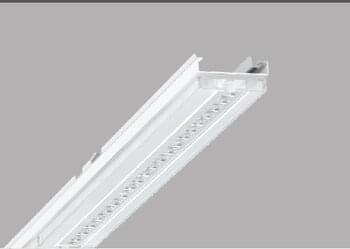
8.3.1 Individual.Lens.Optic
In the combination of LED and spot lens, the effective area of the lens is only located over the LED light points themselves and not over the entire circuit board. Spot lenses made of PMMA (acrylic glass) have a special, light technology calculated structure whereby the light is focused, emitted and distributed. Spot lens deliver a particularly efficient form of light control with a high degree of efficiency and optimised all-round glare control. The light distribution can be wide, narrow and extremely narrow (high-bay warehouse aisle lighting). A double asymmetrical light distribution curve is also possible. The latter is preferred in sales rooms such as discount stores or specialist markets and using vertical lighting levels it allows goods to be selectivly illuminated from both sides of the sales aisles. Industrial applications of the symmetrically distributing spot lens luminaires can be found in factory halls and warehouses. The LED is maintained as a visible light point in the appearance of the luminaire.
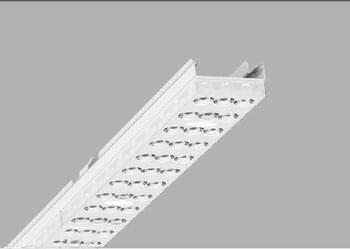
8.3.2 Linear.Lens.Profil
This type of lens made of PMMA (acrylic glass) is the preference for light technology of linear LED modules. Linear lenses have a special, light technology calculated structure whereby the light is focused, emitted and distributed. Linear lenses deliver a particularly efficient form of light control with a high degree of efficiency. The light distribution can be wide, narrow and extremely narrow (high-bay warehouse aisle lighting). A double asymmetrical light distribution curve is also possible. The latter is preferred in sales rooms such as discount stores or specialist markets and using vertical lighting levels it allows goods to be selectivly illuminated from both sides of the sales aisles. Industrial applications of the symmetrically distributing linear lens luminaires can be found in factory halls and warehouses. The appearance of the linear lens is perceived as a light line.
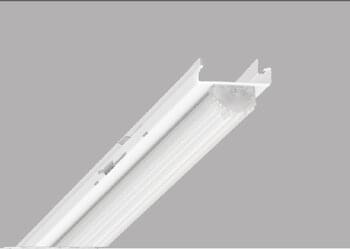
8.3.3 Fresnel lens
This lens is characterised by a special design with a grooved structure. Developed as a linear lens, the design is reduced to a pane made of PMMA (acrylic glass) calculated by light technology and is used in LED luminaires among other things. The light is bundled and focused via different angles of refraction, whereby asymmetrical distributions are also possible. This is used for example for furniture luminaires for cove lighting or for lighting of vertical areas.
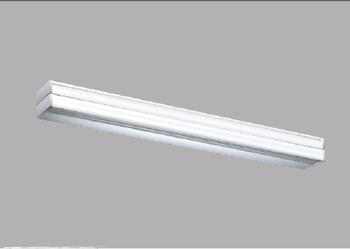
8.3.5 Multi-layer light technology
This light direction is based on the intelligent combination of different film layers that generate the required overall light characteristic with their specific properties. The aim is to avoid undesired point luminance through targeted diffusion – in one or two layers – so that a gentle, homogeneous appearance is generated for the eye. In addition, there is a specially developed light directing layer that ensures appropriate glare reduction. The multi-layer technology enables excellent glare reduction values with UGR ≤19 and luminances < 3000 cd/m² despite relatively small light-emitting surfaces.
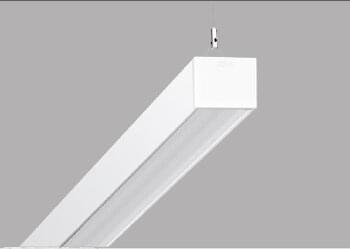
8.3.6 Microprismatic pane
With the edge feeding principle, the LED chips of a luminaire are not classically oriented in the direction of the light-emitting surface, but first couple their light laterally into a multi-layer lighting technology. In this process, the light is further reflected by means of a light transport disc and then directed upwards and outwards. If no or only a reduced indirect component is to be generated, the diffuser has additional reflective areas on the top side. At the bottom, the multi-layer technology is completed with a highly effective microprism diffuser with calculated pyramidal prisms. This ensures VDU-compatible lighting with a luminance reduction < 3000 cd/sqm. LED dots are not visible to the observer when this technology is used.
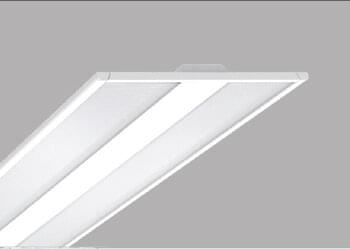
8.3.7 Microprismatic pane with Backlight technology
This high-quality plastic disc made of PMMA (acrylic glass) has pyramidal prisms calculated by light technology. This disc is characterised by homogeneous light distribution and excellent glare reduction, and is also suitable as lighting for computer workstations with a light density threshold < 3000 cd/sqm. In combination with LED, the individual LED light points remain visible, and the luminaire is also perceived as an LED luminaire when switched on. With the planara, an MP disc is used, which has forward-diffusing particles in addition to the prisms. This leads to good glare reduction, as well as a homogeneous appearance under normal viewing angles.
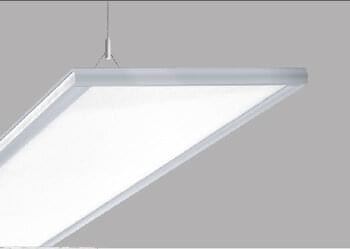
8.3.8 Diffusers with longitudinal prisms
The use of prismatic structures in frosted diffusers makes it possible to modify the radiating characteristics of classic, normal diffuse distribution. A key role here is played by matching the lighting technology to the degree of colouring in the diffuser material. Forward-diffusing nano-particles in the plastic of the diffuser boost the lighting technology effect with no negative impact on the optical appearance. Thanks to these fillers and their lighting technology properties, outstanding system efficiencies of up to 176 lm/W can be achieved for diffuser luminaires without the homogeneous effect of the illumination having to suffer. The surface of the diffuser tray is smooth on the outside and thus easy to clean. Diffusers with narrow/wide radiating characteristics are ideal for low shelving spaces, for example, where the shelves reach up to the ceiling. The upper shelf areas are sufficiently illuminated by the indirect component of the diffuser surfaces at the side.
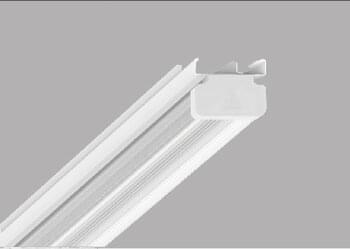
8.3.9 Diffusers
Diffusers can be designed either as panes or in a tub shape. PMMA (acrylic glass) or polycarbonate are used as materials; in harsher industrial applications the panes can also be made of single-pane safety glass. The optics are categorised as clear, clear with a prismatic structure, iced (satined) and opal. The light technology of the covers differs in terms of the degree of transmission and also in the efficiency level. Especially iced and opal designs provide a calm and unifying finish to the luminaires. For example, quadratic recessed luminaires have an effect of roof lighting. Angular diffusers have lit side sections and in this way generate an indirect proportion for modest ceiling illumination. Example applications are administration rooms without screens, classrooms, sales rooms and industry.
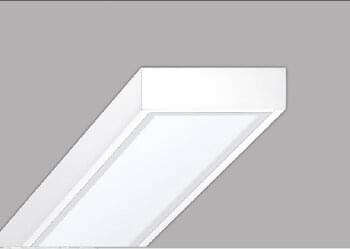
8.3.10 Louvre
Luminaire louvres are composed of metal components and consist of louvre side sections and transverse lamellars. The side sections influence the light distribution of a luminaire depending on their shape and ensure transverse glare control, while the lamellars are primarily used to control longitudinal glare. High quality louvres are made of parabolic aluminium louvre elements, whereby the surface is anodised as either highly reflective or silk matt. Special designs such as the micro louvre with low transverse lamellars allow very flat luminaires and they have a supplementary reflection enhancing silver coating. The high degree of efficiency that is therefore possible combined with exact glare limitation produces a very comfortable level of lighting for vision, for example for VDU workstations. The luminance above the threshold emission angle of 65° is therefore reduced to <1000 cd/m2. Disruptive reflections on screens are avoided. Other application areas are representative spaces such as meeting rooms, conference rooms and reception areas. Specular louvre luminaires can also asymmetrically radiate light and illuminate vertical surfaces such as blackboards or presentation surfaces - if necessary with asymmetrically arranged lamp positions.
Simple louvre versions with white surfaces are used in spaces with lower light technology requirements, for example in corridors and waiting areas.
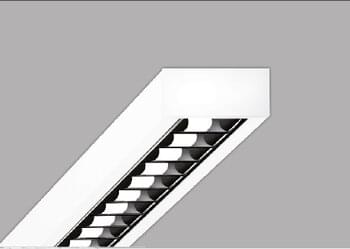
8.4 MAINTENANCE
In order to maintain light output ratios, regular cleaning of luminaires is intended and makes sense. Lighting technology often features high-grade optical surfaces and must therefore be handled very carefully. Both mechanical loads (wiping, rubbing etc.) as well as the use of unsuitable cleaning agents must be avoided, as both can lead to impairment or even destruction of the optical characteristics of surfaces (see figure 8.1.7.). Residues of cleaning agents may furthermore cause smudges and streaks that might negatively effect light control. We would be glad to give you detailed information concerning the proper cleaning of luminaires.
8.5 SPECIAL LUMINAIRES AND MODIFICATIONS
Special versions with electrical or mechanical modifications as well as special coatings in accordance with RAL colours can be supplied at extra cost following assessment of feasibility. Customized luminaires undergo the same inspections at Regiolux as standard luminaires.
8.6 CERTIFICATION, PROTECTION CLASS AND PROTECTION RATING
All Regiolux luminaires are manufactured according to approved technical standards and 100% electrically tested. The luminaires are designed as standard for 230 V, 50 Hz and an ambient temperature of 25° C, and satisfy European norms and directives, including ENEC provisions in relation to safety, electromagnetic compatibility and energy efficiency.
 |
Luminaires with the indoor symbol according to IEC 60417-5957 are only suitable and approved for indoor use. |
 |
Luminaires of protection class I must be connected to a protective earth conductor. . |
 |
Luminaires of protection class II are insulated against live parts; a protective earth connection is not permitted. |
|
|
Luminaires of protection class III are approved for operation on safety extra-low voltage < 50V (effective). |
| First digit | Brief description | Brief details of which foreign objects cannot penetrate the enclosure |
| 0 | Unprotected | No special protection. |
| 1 | Protected against solid objects > 50 mm | Any large surface of the body, such as the back of the hand, (but no protection against deliberate contact with a body part); solid foreign objects. |
| 2 | Protected against solid objects > 12 mm | Fingers or similar objects up to 80 mm length; solid foreign objects over 12 mm in diameter. |
| 3 | Protected against solid objects > 2.5 mm | Tools, thick wires, etc with a diameter or thickness > 2.5 mm; solid foreign objects over 2.5 mm in diameter. |
| 4 | Protected against solid objects > 1 mm | Wires or strips thicker than 1 mm; solid foreign objects over 1 mm in diameter. |
| 5 | Dust-protected | Ingress of dust is not entirely prevented, but it does not enter in quantities sufficient to interfere with the correct operation of the equipment . |
| 6 | Dust-tight | No ingress of dust. |
| Second digit | Brief description | Details of the protection provided by the enclosure |
| 0 | Unprotected | No special protection. |
| 1 | Protected against dripping water | Dripping water (vertically falling drops) shall have no harmful effect. |
| 2 | Protected against dripping water when tilted up to 15° | Vertically dripping water shall have no harmful effect when the enclosure is tilted at an angle up to 15° from its normal position. |
| 3 | Protected against spray water | Water falling as a spray at any angle up to 60° from the vertical shall have no harmful effect. |
| 4 | Protected against water splashes | Water splashing against the enclosure from any direction shall have no harmful effect. |
| 5 | Protected against water jets | Water projected by a nozzle against the enclosure from any direction shall have no harmful effects. |
| 6 | Protected against heavy seas | Ingress of water in a harmful quantity shall not be possible from heavy seas or when projected against the enclosure under high pressure. |
| 7 | Protected against the effects of immersion | Ingress of water in a harmful quantity shall not be possible when the enclosure is immersed in water under defined conditions of pressure and time. |
| 8 | Protected against submersion | The equipment is suitable for continuous immersion in water under conditions which shall be specified by the manufacturer. Normally, this will mean that the equipment is hermetically sealed. However, with certain types of equipment, it can mean that water can enter but only in such a manner that it causes no harmful effects. |

 -symbol is the European safety symbol for luminaires. The testing regulations are specified in DIN EN 60598. The
-symbol is the European safety symbol for luminaires. The testing regulations are specified in DIN EN 60598. The 

 -symbol in production areas where dust and/or fibres pose a fire hazard and must at least fulfill protection rating IP50. Installation instructions must be observed during mounting
-symbol in production areas where dust and/or fibres pose a fire hazard and must at least fulfill protection rating IP50. Installation instructions must be observed during mounting
 -symbol are intended for surface-mounted and recessed installation in furniture. They are constructed so that in the case of luminaire failure, normal or low-flammability materials cannot be ignited according to VDE 0710 Section 14. In order to avoid incorrect installation, installation instructions must be observed.
-symbol are intended for surface-mounted and recessed installation in furniture. They are constructed so that in the case of luminaire failure, normal or low-flammability materials cannot be ignited according to VDE 0710 Section 14. In order to avoid incorrect installation, installation instructions must be observed.






 -mark is applied by the manufacturer. The manufacturer is thus responsible for confirming conformity with the relevant EU directives. Conformity to the “Low Voltage Directive” 2006/95/EC, the “EMC Directive” 2004/108/EC (immunity to interference, emitted interference) and energy efficiency (directives 2005/32/EC and EC 245/2009) are the pre-requisites for the
-mark is applied by the manufacturer. The manufacturer is thus responsible for confirming conformity with the relevant EU directives. Conformity to the “Low Voltage Directive” 2006/95/EC, the “EMC Directive” 2004/108/EC (immunity to interference, emitted interference) and energy efficiency (directives 2005/32/EC and EC 245/2009) are the pre-requisites for the 






 , but have not been specifically certified by the Fraunhofer-Institut IPA.
, but have not been specifically certified by the Fraunhofer-Institut IPA.
